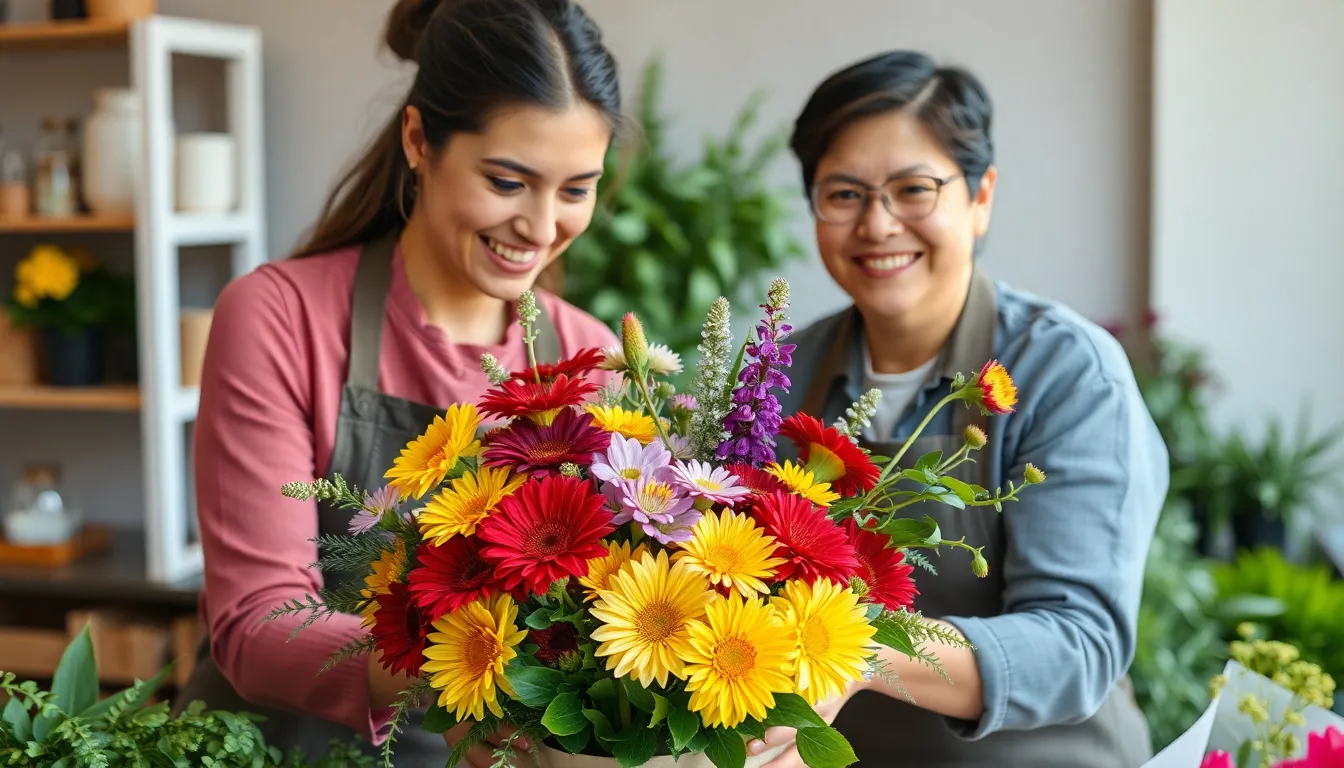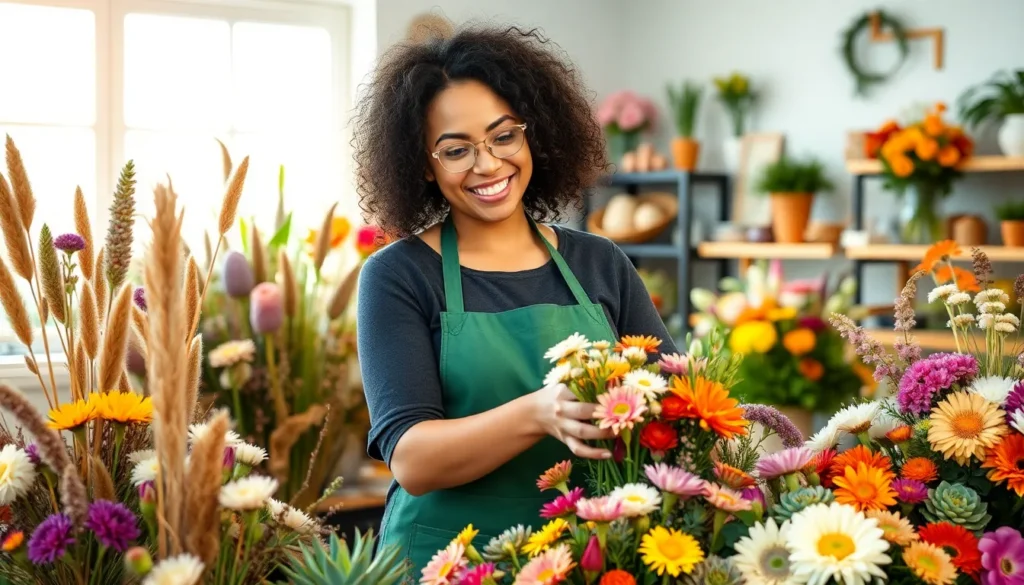The floral industry is blooming like never before, and it’s not just about roses and daisies anymore. With fresh trends sprouting up, it’s time to dig deeper into what’s captivating hearts and homes. From sustainable practices that make Mother Nature proud to the rise of unique floral designs that could make even a cactus blush, the landscape of flowers is evolving rapidly.
Gone are the days when flowers were merely a last-minute gift. Today, they’re a statement—an expression of personality and style. Whether it’s the latest color palettes or innovative delivery methods, the floral world is buzzing with creativity. So, grab your favorite vase and get ready to explore the exciting trends that are shaping the future of floristry. Who knew flowers could be this much fun?
Floral Industry Trends
The floral industry rapidly adapts to consumer preferences and market demands. Sustainable practices represent a significant trend; growers are focusing on eco-friendly methods to reduce environmental impact. Cut flowers sourced from local farms often showcase fresher quality and support regional economies.
Unique floral designs have gained popularity, moving away from traditional arrangements. Creative compositions that emphasize texture and color variety attract attention, reflecting personal style and current aesthetics. Organic shapes and asymmetrical arrangements stand out in this evolving landscape.
Corporate floral gifting displays a shift toward personalization. Customers now seek tailored bouquets that resonate with a recipient’s taste, enhancing emotional connections. This trend encourages florists to innovate and create designs that embody individual sentiments.
Digital platforms play a crucial role in shaping buying behaviors. E-commerce growth allows consumers to access incomparable selections, whether local or international. Online resources provide educational content, empowering customers to explore floral care, arrangement techniques, and current industry trends.
Seasonal flowers are increasingly favored, aligning with consumers’ desire for freshness and variety. Festivals and events often feature specific blooms that reflect seasonal themes, enhancing decor and atmosphere. Moreover, florists are curating collections that celebrate biodiversity to appeal to conscious shoppers.
Finally, wellness-oriented practices are on the rise; flowers are recognized for their psychological benefits. Studies indicate that floral presence can improve mood and reduce stress levels. This perspective fuels interest in bringing nature indoors, enhancing the overall buying experience.
Sustainability in Floral Design

Sustainability plays a crucial role in modern floral design, shaping how consumers and florists approach floral arrangements. Eco-friendly methods prioritize environmental health while meeting market demands.
Eco-Friendly Practices
Emphasizing reduced carbon footprints, many growers adopt sustainable farming techniques. These practices include organic cultivation, minimizing chemical use, and implementing water conservation strategies. Techniques such as crop rotation and polyculture further enhance soil health. Supporting local flower farms also reduces transportation emissions while boosting regional economies. Florists increasingly source seasonal blooms, showcasing local varieties and promoting sustainable purchasing. Consumers are recognizing the positive impact of choosing environmentally responsible flowers, aligning their purchases with their values.
Biodegradable Products
Biodegradable materials are becoming standard in floral design. Instead of plastic, many florists utilize compostable containers, ensuring minimal waste. Natural fibers, such as jute and bamboo, serve as eco-friendly alternatives for wraps and bouquets. These materials break down over time, reducing landfill contributions. Additionally, some growers offer compostable floral foam, replacing traditional options that harm the environment. By integrating biodegradable products, the floral industry embraces sustainability while appealing to eco-conscious consumers. This shift reflects a broader trend towards responsible consumption and environmental stewardship.
Technology in the Floral Industry
Technology is rapidly transforming the floral industry, enhancing the way consumers interact with florists and purchase flowers.
Online Flower Delivery Services
Online flower delivery services streamline the purchasing process. Consumers can browse an extensive selection of bouquets from various florists at their convenience. Many platforms now offer same-day delivery, increasing accessibility to fresh flowers for last-minute occasions. As a result, local businesses benefit from e-commerce growth, broadening their customer base. Data indicates that approximately 75% of flower purchases occur online, highlighting the significance of the digital marketplace. Online shopping has also integrated personalized recommendations, tailoring experiences to individual tastes and preferences.
Use of Augmented Reality
Augmented reality (AR) enhances the floral shopping experience with innovative technology. Customers can visualize how arrangements will look in their space before making a purchase. Many retailers incorporate AR tools into their apps or websites, allowing users to virtually place bouquets in various settings. This technology boosts consumer confidence in their choices and reduces the likelihood of returns. According to industry reports, AR can increase engagement by over 40%, driving higher sales conversion rates. Integration of AR moves the floral industry toward an interactive future, providing a competitive edge in an evolving market.
Consumer Preferences and Demographics
Consumer preferences within the floral industry reflect evolving demographics and lifestyle choices. Millennials play a significant role in shaping floral purchases, with their preferences driving trends toward sustainability and personalization. They prioritize eco-friendly options, often favoring locally sourced flowers that support regional economies. A desire for unique arrangements also prevails, with Millennials frequently opting for designs that enhance their personal style and home aesthetics.
Millennials and Floral Purchases
Millennials strongly influence floral purchases, making them a key demographic in the sector. This generation favors experiences over possessions, leading to increased consumption of flowers for events and special occasions. According to recent research, 70% of Millennials prefer receiving flowers that reflect their personality rather than traditional bouquets. Their inclination towards sustainable practices drives demand for growers who implement eco-friendly methods. Social media also plays an essential role, as Millennials share floral arrangements online, inspiring others to engage with floral products.
The Rise of Subscription Services
Subscription services have gained massive popularity in the floral market, catering to consumers’ desire for convenience and consistent quality. This trend offers regular deliveries of fresh flowers, appealing to busy lifestyles while simplifying the buying process. Reports indicate that subscription services can increase customer loyalty, with subscribers often spending 30% more than one-time purchasers. Additionally, these services enable consumers to discover new floral varieties and seasonal blooms throughout the year, enhancing their appreciation for flowers. The ease of setting preferences for style and frequency further fuels the appeal of subscription models within the floral industry.
Floral Design Innovations
Innovations in floral design are reshaping the industry, emphasizing creativity and sustainability. New approaches cater to evolving consumer preferences.
Dried and Preserved Flowers
Dried and preserved flowers are trending due to their longevity and aesthetic appeal. Many florists now offer these options, which require less maintenance than fresh blooms. Techniques like air drying and silica gel preservation allow for vibrant colors and unique textures. Customers appreciate the environmental benefits, as these flowers have a longer lifespan, reducing waste. This trend aligns with sustainable practices, appealing to consumers who seek eco-friendly decor. Collections featuring diverse species encourage exploration and personalization in home aesthetics.
Unique Floral Arrangements
Unique floral arrangements capture attention with their artistic flair and customization. Designers craft pieces that break traditional boundaries, incorporating unexpected elements like fruits, succulents, and unusual foliage. These arrangements reflect individual tastes and contribute to personal branding, particularly in events and weddings. The focus on textures, shapes, and color combinations creates visual interest that resonates with customers. Additionally, innovative presentation methods, such as vertical gardens or hanging installations, elevate the overall experience. Personalization drives demand, making each arrangement a thoughtful expression rather than a generic gift.
Conclusion
The floral industry is experiencing a remarkable transformation driven by sustainability and creativity. As consumers increasingly seek personalized and eco-friendly options, florists are adapting to meet these demands. The rise of technology is enhancing the shopping experience, making it easier for people to connect with flowers in meaningful ways.
With trends like dried arrangements and unique compositions gaining traction, flowers are becoming more than just gifts; they’re a form of self-expression. As the industry continues to evolve, it’s clear that the future of floristry will be shaped by innovation and a commitment to environmental responsibility. This dynamic landscape promises exciting opportunities for both consumers and florists alike.



